Tallying up the posts and uploaded images for the month of September, I find that not only did I set a record for the year-to-date for images posted (127,) but it would only take seven more to beat the total for any year that I’ve been posting: last year was the record-holder with 747, and I am presently at 741… with six images lined up to be included in this post ;-). And that’s with only one decent trip this year, so it’s mostly local photos. I can live with that. As an amusing side note, you can see where I was not quite six years ago with this post.
Actual posts is another matter. I’m presently at 166 posts, with the record being 218. That’s 52 more in the next three months to tie; attainable, and within the average per month this year, but we’re also entering the slow months. Also, I’m aware that this kind of goal hovering over my head may be encouragement towards more frivolous, throwaway posts (not that I’m necessarily averse to those,) and don’t want to inflate the numbers with dross just to reach an arbitrary total, part of the reason this post is doing double-duty, as it were.
Because it’s also a follow-up, taking note of what I didn’t accomplish this year, which was catching certain behaviors from the mantids. It’s been a long-term goal to capture both mating and egg-laying behavior, since I’ve largely documented all else, but these have been eluding me (save for a single image of each from several years back,) and this year was no exception. I thought I was getting ironically lucky when, on the same day that the last update was posted, I found a female Carolina mantis (Stagmomantis carolina) with an enormously swollen abdomen, indicative of laying eggs very soon. But something was amiss.
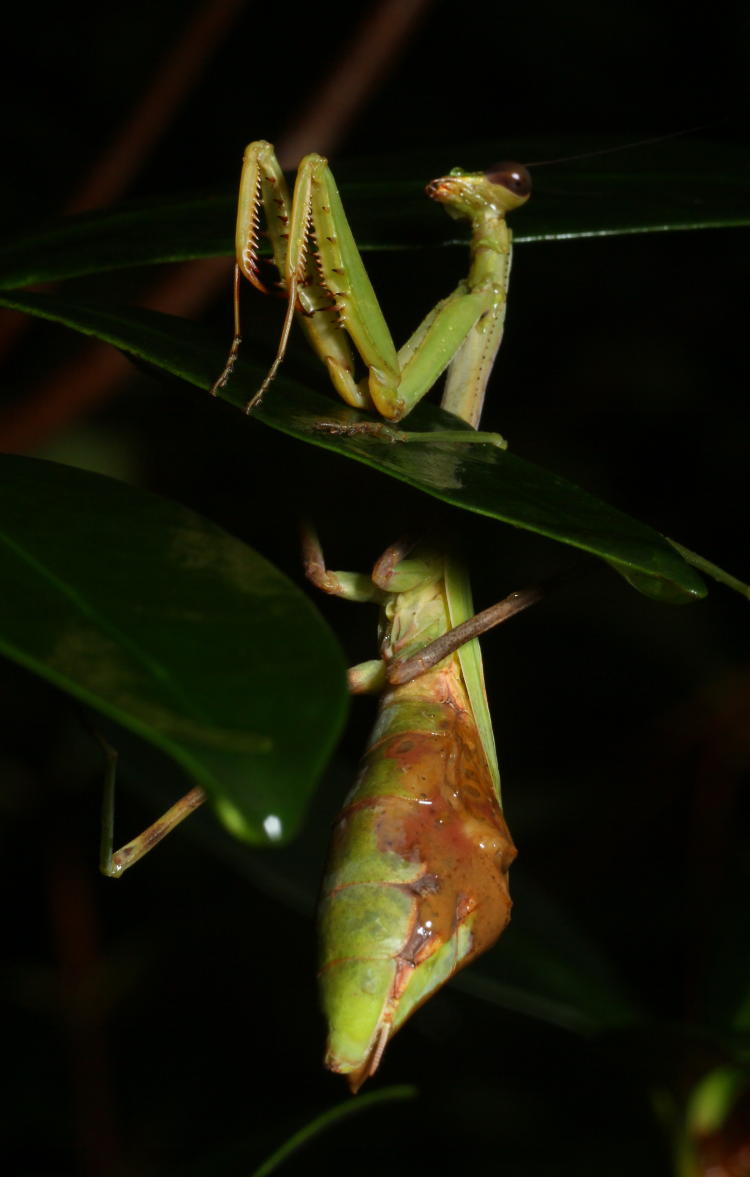
Appearing a little over my head at night after a rain, I thought something didn’t look quite right, but it took an examination of the photos to see the details clearly – I have others that show it even better, but they’re kinda graphic. Her abdomen is ruptured laterally, seemingly along a segment line, and I couldn’t begin to tell you how or why. She ended up dying right there after a day, which is a shame because she certainly looked ready to place the egg sac.
A couple weeks later, I found a Chinese mantis (Tenodera sinensis) within two meters of the same spot, this time on the Japanese maple.
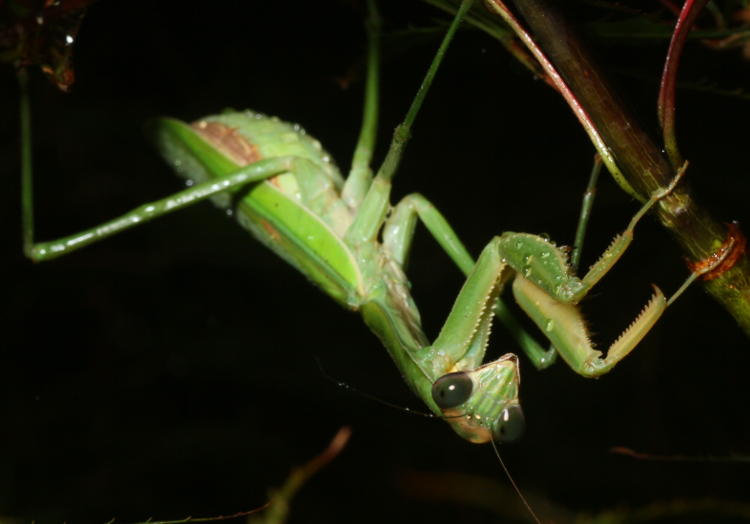
This one was during a rain, but also looking about ready to throw down some sac, as they say (no one says that.) I didn’t want to disturb her and either delay the process or convince her the location was unsafe, so I attempted to monitor her with quick periodic checks. Throughout the night she made no actions at all save to shift position slightly, and by morning she was nowhere to be seen. This is the same Japanese maple mentioned in that linked post, bearing an egg sac from last year as well as having hosted a transplanted one of my own; I photographed newborns emerging from the latter, but didn’t even know about the former until well after hatching season. Regardless, she may have returned to the tree because that’s where she was born, if mantids actually do that. Or it may simply be it’s a very dense plant with ideal branches for such.
That density may have worked against me, because after another few days, I found a mantis atop it again, this one looking much thinner.
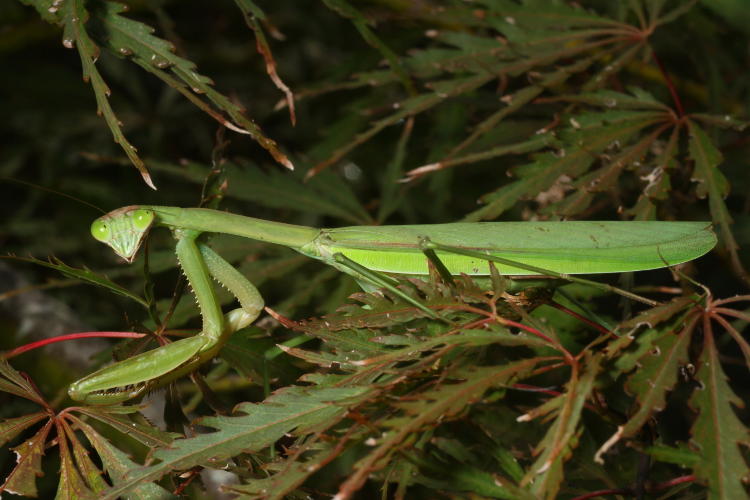
Was it the same one, post-partum? I have no way of knowing, except that the tree (and really, the entire property within my examination) has been largely devoid of mantids, so the timing is suspicious, to say the least. And when I first found her in this trim state, she was about 20cm from the previous year’s egg sac. But I’ve examined the tree carefully, multiple times over because I knew I’d be making this post, and have not (yet) found a new sac anywhere – this may not mean much, because as I said, the foliage is dense, so dense that individual branches can barely be made out even when standing right next to the tree. Which stands all of 1.5 meters tall and 2 across, give or take, so it’s not like any portion is out of reach. At some point, I’ll crawl underneath to frame the entire canopy against the bright sky and see if I can spot anything that way.
But since she was handy, and I wasn’t likely to disturb anything…
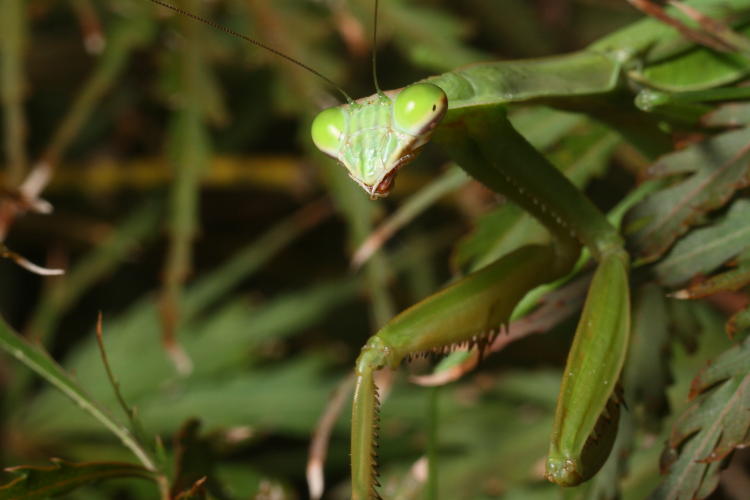
I did a few quick portraits – again, trying not to spook her too much even though she wasn’t going to be depositing any eggs soon. This one shows the entire frame, no cropping, just resized to fit the blog. The next one is going to be a full-resolution inset of the same, because if the Mamiya 80mm macro is going to capture this detail, by dog I’m going to show it off.
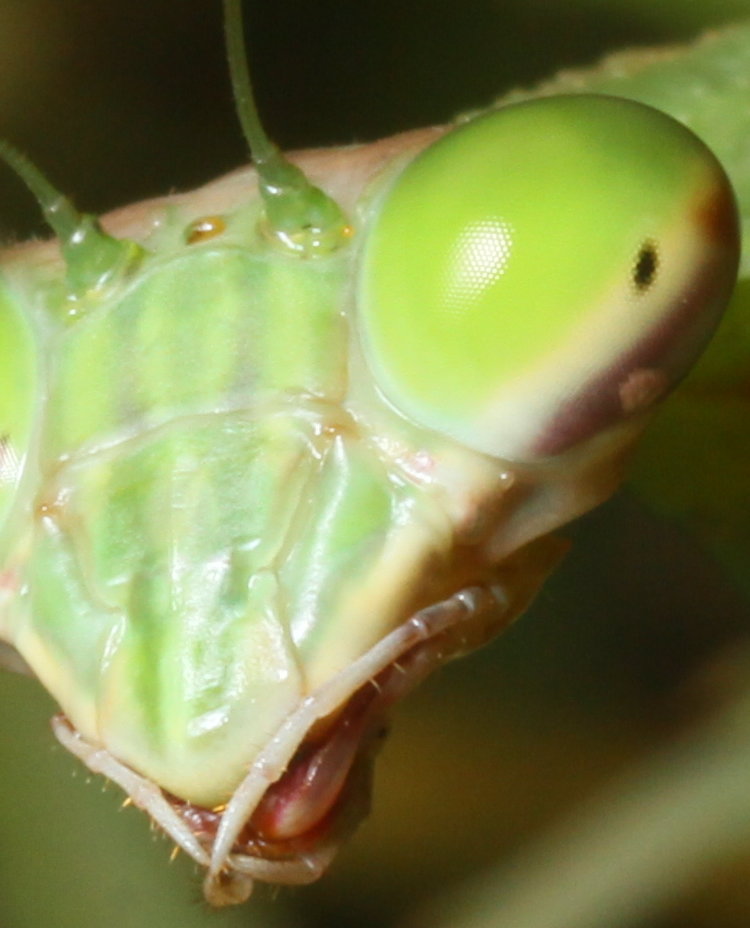
How about that, hah? Hah? You want tiny little compound eye facets, I’m gonna give you tiny little compound eye facets. This is with the increased megapixels of the Canon 7D that I picked up some months back, but as I’ve said before, they’re not going to help you unless you have the lens to resolve that much, and the Mamiya certainly does. Plus we get to see the ‘fuzziness’ of the false pupil, which is actually an artifact of seeing the individual ommatidia at certain angles. But I have more frames, from the same brief session, that illustrate this curious trait pretty well.

Taken only moments apart, the mantis tipped her head slightly differently for each, and the false pupil shifted in such a way as to imply direction of gaze, even though with compound eyes, the mantis can see in a buttload of directions at once. However, the eyes are optimized for binocular, depth-perceiving vision as well, to help them track and seize prey, so mantids will indeed turn their head to line up this ideal field of view.
So that’s where the mantis saga stands – I haven’t found this one for a few days now. I suppose there’s still a chance that I might see some late activity, but I’m not holding my breath, and am resolved to picking this up again next spring. I did at least get some distinct video and super-detailed hatching shots this year, so progress is being made. And, you know, if someone wants to pay for such images, I’ll be happy to devote more time and effort into the pursuit, and probably spark a bit more success…




















































